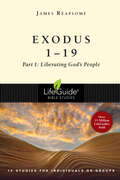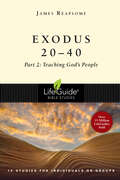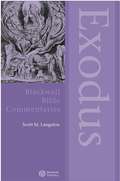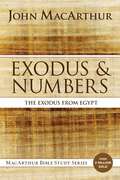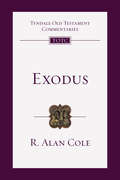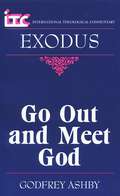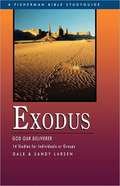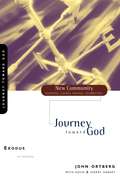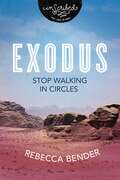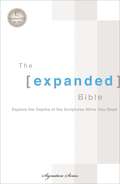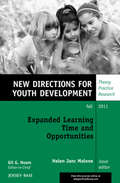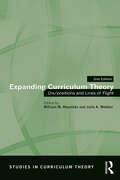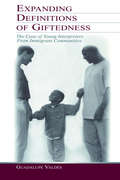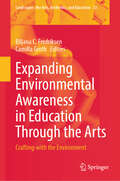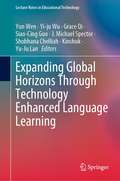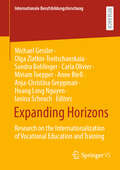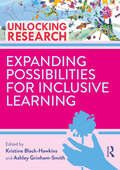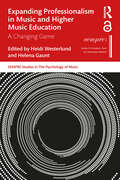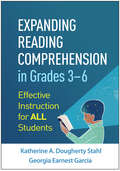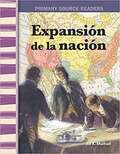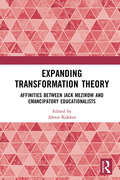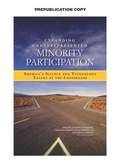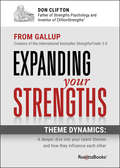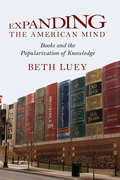- Table View
- List View
Exodus 1--19: Liberating God's People (LifeGuide Bible Studies)
by James W. ReapsomeTrust God. Sounds simple, right? Yet, you know it is often very, very difficult to trust God with the things that matter most to you���money, career, marriage, health. As you study the book of Exodus, you'll see that Israel faced similar struggles to trust God completely. In this story of hardship and hope, you'll discover along with Israel that God���and God alone���is worthy of our trust. In this twelve-session LifeGuide Bible Study features questions for starting group discussions and for meeting God in personal reflection. Leader's notes are included with information on study preparation, leading the study and small group components as well as helps for specific Bible passages covered in the study. Presented in a convenient workbook format and featuring the inductive Bible study approach, LifeGuides are thoroughly field-tested prior to publication; they're proven and popular guides for digging into Scripture on your own or with a small group. For over three decades LifeGuide Bible Studies have provided solid biblical content and raised thought-provoking questions���making for a one-of-a-kind Bible study experience for individuals and groups. This series has more than 130 titles on Old and New Testament books, character studies, and topical studies. PDF download with a single-user license; available from InterVarsity Press and other resellers.
Exodus 20-40: Part 2: Teaching God's People (LifeGuide Bible Studies)
by James W. ReapsomeTrust God. Sounds simple, right? Yet, you know it is often very, very difficult to trust God with the things that matter most to you���money, career, marriage, health. As you study the book of Exodus, you'll see that Israel faced similar struggles to trust God completely. In this story of hardship and hope, you'll discover along with Israel that God���and God alone���is worthy of our trust. In this twelve-session LifeGuide Bible Study features questions for starting group discussions and for meeting God in personal reflection. Leader's notes are included with information on study preparation, leading the study and small group components as well as helps for specific Bible passages covered in the study. Presented in a convenient workbook format and featuring the inductive Bible study approach, LifeGuides are thoroughly field-tested prior to publication; they're proven and popular guides for digging into Scripture on your own or with a small group. For over three decades LifeGuide Bible Studies have provided solid biblical content and raised thought-provoking questions���making for a one-of-a-kind Bible study experience for individuals and groups. This series has more than 130 titles on Old and New Testament books, character studies, and topical studies. PDF download with a single-user license; available from InterVarsity Press and other resellers.
Exodus Through the Centuries (Wiley Blackwell Bible Commentaries #5)
by Scott M. LangstonThis bible commentary looks at how Exodus has influenced and has been influenced by history, religion, politics, the arts and other forms of culture over the ages. A bible commentary tracing the reception history of Exodus from Old Testament times, through the Patristic and Reformation periods, to the present day. Considers the ways in which Exodus has influenced and has been influenced by history, religion, politics, the arts and other forms of culture in Jewish, Christian and secular settings. Looks at how Exodus has served as a tool of liberation and tyranny in a variety of settings. Shows how Exodus has been used to shape the identities of individuals and groups. Discusses the works of current and past poets, musicians, film-makers, authors and artists influenced by Exodus. Addresses uses of Exodus related to American and European history such as the Glorious Revolution, colonialism, the American Revolution, Civil War, Civil Rights Movement, African-Americans, and Native Americans, as well as uses by prominent and little-known historical figures Considers the impact of the Ten Commandments and other laws, in legal, political and religious contexts. The Blackwell Bible Commentary series is supported by a website at www.bbibcomm.net
Exodus and Numbers: The Exodus from Egypt (MacArthur Bible Studies)
by John F. MacArthurAlthough the descendants of Jacob moved to Egypt as honored guests, in time they became despised slaves groaning under the mistreatment of Pharaoh. In response to the people's cries, God called a man named Moses to lead the Israelites out of Egypt into Canaan, but their journey took a dramatic forty-year detour when they failed to trust in God.In this study, pastor John MacArthur will guide you through an in-depth look at the historical period beginning with God's calling of Moses, continuing through the giving of the Ten Commandments, and concluding with the Israelites' preparations to enter the Promised Land.This study includes close-up examinations of Aaron, Caleb, Joshua, Balaam and Balak, as well as careful considerations of doctrinal themes such as "Complaints and Rebellion" and &“Following God's Law."—ABOUT THE SERIES—The MacArthur Bible Study series is designed to help you study the Word of God with guidance from widely respected pastor and author John MacArthur. Each guide provides intriguing examinations of the whole of Scripture by examining its parts and incorporates:Extensive, but straight-forward commentary on the text.Detailed observations on overriding themes, timelines, history, and context.Word and phrase studies to help you unlock the broader meaning and apply it to your life.Probing, interactive questions with plenty of space to write down your response and thoughts.
Exodus: An Introduction and Commentary (Tyndale Old Testament Commentaries #Volume 2)
by R. Alan ColeExodus, Cole says, is "the centre of the Old Testament." It recounts the supreme Old Testament example of the saving acts of God, narrates the instituting of Passover and enshrines the giving of God's law. It portrays Moses, the prototype of all Israel's prophets, and Aaron, the first high priest. The book of Exodus is especially important to Christians because Christ fulfilled its great themes: He accomplished God's greatest act of deliverance. He became the passover lamb. He sealed a new covenant with his blood. "No book therefore will more repay careful study, if we wish to understand the central message of the New Testament, than this book." The original, unrevised text of this volume has been completely retypeset and printed in a larger, more attractive format with the new cover design for the series.
Exodus: Go Out and Meet God
by Godfrey AshbyThe book of Exodus is often seen only as ancient history, largely irrelevant to most of the modern Western world. This new commentary by Godfrey Ashby attempts specifically to show how this Old Testament book is of continuing significance to readers today. Ashby discusses the crucial importance of the events described in Exodus and their meaning for the Old Testament gospel, and explains why the Exodus event is central to the gospel of Jesus Christ and to the faith of believers in our own age. He also explores the relevance of Exodus for the liberation struggle now taking place throughout the third world.
Exodus: God Our Deliverer (Fisherman Bible Studyguide Series)
by Sandy Larsen Dale LarsenThese fourteen studies for individuals or groups on the book of Exodus are part of the Fisherman Bible Studyguide series.
Exodus: Journey Toward God (New Community Bible Study Series)
by John Ortberg Kevin G. Harney Sherry HarneyConsult the compass for the journey of your life. Life as a Christian is a journey -- a journey toward God. But how do you set your compass? How do you make sure that God is guiding your steps and that you are not being blown willy-nilly by life's shifting winds of circumstance? Turn to the book of Exodus and discover guidance and joy for your pilgrimage. You will grow to know God in a deeper, more personal way. You will learn to trust him more than ever before. You will discover who your fellow travelers are. And you will learn how to chart your course by the compass of God's will as you take the trip of your life.
Exodus: Stop Walking in Circles (InScribed Collection)
by Rebecca BenderLessons from the book of Exodus: learn how to stop walking in circles and rely on God's grace to show you the way to his good promise. Do you wonder if you'll ever get back on track after suffering a major setback or traumatic experience? Do you wonder—even secretly—if God actually does keep his promises? Or if his love is far-reaching enough, his plan detailed enough to include even your daily struggles, habits, and hang-ups?In this Bible study, Rebecca Bender takes study groups and individuals straight into the book of Exodus where the Israelites are wandering after their own tracks immediately after escaping from bondage and oppression at the hands of Pharaoh. God is trying to get them to the land of his promise, but they, like many of us, are frustrated by doubts, fears, and self-destructive habits...This study guide will equip you to:See Exodus in a new and relatable way that will help you better understand God and yourself.Understand the historical and cultural nuances of Egypt to give you fresh insight into this powerful story.Learn applicable tips from the children of Israel by understanding what they did right and what they did wrong in order to reach their goals.Move beyond your own past and into your promises.Get back on track after experiencing a major setback in life or enduring a traumatic event.God has called you out of bondage—to sin, to doubt, to defeat—and into his Promised Land that flows with his grace and truth.This study guide includes biblical and historical background insights, practical application, group discussion questions, and a memory verse for each chapter.Inscribed is a collection of studies that lead women to not just survive but thrive by encouraging them to immerse themselves in the Word of God.
Expanded Bible: New Testament
by Thomas NelsonExplore the Depths of the Scriptures While You ReadExpect understanding! Experience the full meaning of God's Word. The Expanded Bible has been developed by a respected team of skilled Bible translators to make God's Word easier to understand--and more relevant and real for today's Christian--with innovative expansions in the text itself that exhibit the complete meaning of each passage in its context--while you read.Perceive what God is saying in language that's easy to understandDiscover the significance of each passage with helpful expansions in the textComprehend full meaning with alternative, literal, and traditional wordingsUnderstand the Bible's culture and setting with descriptive comments where neededCompare scripture with scripture using key cross-referencesAdd your own expansions and observations in wide margins on every pagePart of the Signature Series line of Thomas Nelson Bibles. Contributing scholars: Tremper Longman III, Mark L. Strauss, Daniel Taylor
Expanded Learning Time and Opportunities: New Directions for Youth Development, Number 131 (J-B MHS Single Issue Mental Health Services #110)
by Helen Janc MaloneExpanding the learning day is gaining national momentum as an important school-improvement and whole-child development strategy. This issue focuses on school-community partnerships that provide a seamless, longer learning day that best meets the academic (Expanded Learning Time or ELT) and developmental (Expanded Learning Opportunities or ELO) needs of high-poverty students in resource-poor communities. First it draws attention to the importance of ELOs and offers contours of the ELT-ELO partnerships through research evidence and policy analysis. It then covers both in practice and features a spectrum of ELT-ELO partnerships, from less to more integrated models. The issue pays close attention to: The central role ELOs play in ELT schools The changing safeguards for community-based organizations Ways in which current education policy is shaping the approach of schools and community partners to learning and development. This is the 131st volume of New Directions for Youth Development, the Jossey-Bass quarterly report series dedicated to bringing together everyone concerned with helping young people, including scholars, practitioners, and people from different disciplines and professions.
Expanding Curriculum Theory: Dis/positions and Lines of Flight (Studies in Curriculum Theory Series)
by William M. Reynolds Julie A. WebberExpanding Curriculum Theory, Second Edition carries through the major focus of the original volume—to reflect on the influence of Deleuze and Guattari’s concept of "lines of flight" and its application to curriculum theorizing. What is different is that the lines of flight have since shifted and produced expanded understandings of this concept for curriculum theory and for education in general. This edition reflects the impact of events that have contributed to this shift, in particular the (il)logic of school policy changes and reforms in the past decade, and the continued explosion of social media and its effect on the collective understanding of how both "knowledge" and "education" work as forms of repression. The introduction updates the text and puts it into current debates in the field and in the larger socio-economic milieu. New dis/positions are presented that explore central questions circulating within and outside curriculum studies. Exciting scholarship on a range of topics includes notions of desire and commodities, youth culture and violence, new directions in curriculum theory, Eco-Ethical consciousness, new Deleuzian views of normality, the diffusion of technology and lines of flight in transnational curriculum inquiry.
Expanding Definitions of Giftedness: The Case of Young Interpreters From Immigrant Communities (Educational Psychology Series)
by Guadalupe ValdesThis book is about bilingual young people who have been selected by their families to carry out the hard work of interpreting and translating to mediate communication between themselves and the outside world--between minority and majority communities. It examines the experiences of these young interpreters and the skills they develop in order to fulfill this role. The authors' purpose in this volume is to contribute to extending current definitions of gifted and talented, by proposing and offering evidence that the young people who are selected to serve as family interpreters perform at remarkably high levels of accomplishment when compared with others of their age, experience, and environment, and should thus clearly be included in the 1993 U.S. federal definition of giftedness. They maintain that not only are these capabilities currently overlooked by existing assessment procedures, but also that there is little understanding of the ways in which the unique talents of young interpreters might be nurtured and developed in academic settings. A strong case is made that in order for such students to be identified as gifted on the basis of their bilingual abilities, the field of gifted and talented education must embrace the concept that bilingualism is a strength. The field must also make developing bilingualism a focus of programs designed to meet the needs of the increasingly multilingual student population in the United States. The research this book reports--part of a larger five-year study of giftedness through linguistic and cultural lenses, funded by OERI through the National Research Center on the Gifted and Talented--was conducted by researchers whose background is very much outside the field of gifted education. Rather, their focus is on language, working within the traditions of qualitative sociolinguistics. Thus, this book offers a unique approach to the exploration of giftedness. It asks researchers and practitioners ordinarily accustomed to working with quantitative data to examine and make sense of detailed and rich analyses of students' linguistic performance, and argues that it is only by understanding the challenges of such bilingual interactions that the field of gifted and talented education can expand and reframe its vision of giftedness.
Expanding Environmental Awareness in Education Through the Arts: Crafting-with the Environment (Landscapes: the Arts, Aesthetics, and Education #33)
by Biljana C. Fredriksen Camilla GrothChapters “Crafting in Dialogue with the Material Environment” and “Soil Laboratory: Crafting Experiments in an Exhibition Setting” are available open access under a Creative Commons Attribution 4.0 International License via [link.springer.com|http://link.springer.com/].thors’ own experiences with phenomena they are trying to understand and critically explore. This book is of interest to professional creative practitioners, art and craft educators, art teacher educators or researchers in the field of creative practices. It has power to inspire rethinking of present educational practices, to ignite critical reflections about materials and more-than-humans, and, hopefully, motivate transformations toward more ecologically sustainable ways of life.
Expanding Global Horizons Through Technology Enhanced Language Learning (Lecture Notes in Educational Technology)
by J. Michael Spector Kinshuk Yun Wen Yi-Ju Wu Grace Qi Siao-Cing Guo Shobhana Chelliah Yu-Ju LanThis book uncovers the important issues in language learning and teaching in the intelligent, digital era. “Social connectivity” is a contemporary style of learning and living. By engaging in the connectivity of physical and digital worlds, how essential parts of language learning and teaching can be achieved? How can the advanced technologies, such as virtual reality and artificial intelligent, be used to solve the problems encountered by language learners? To answer the above mentioned question, plenty of inspiring studies are included in the book. It is a platform of exchange for researchers, educators, and practitioners on the theory and/or application of state-of-the-art uses of technology to enhance language learning.
Expanding Horizons: Research on the Internationalization of Vocational Education and Training (Internationale Berufsbildungsforschung)
by Olga Zlatkin-Troitschanskaia Miriam Toepper Sandra Bohlinger Michael Gessler Carla Olivier Anne Bieß Anja-Christina Greppmair Hoang Long Nguyen Ianina ScheuchThis volume presents selected results from the initiative "Research on the Internationalization of Vocational Education and Training", funded by the German Federal Ministry of Education and Research. The articles show how the projects of the funding program contribute to strengthening and expanding institutionalized vocational education and training research as well as international vocational education and training cooperation. The altogether 35 authors outline and discuss research findings as well as innovative models and ideas for development perspectives.
Expanding Possibilities for Inclusive Learning (Unlocking Research)
by Kristine Black-Hawkins and Ashley Grinham-SmithWhile many teachers articulate a strong commitment to the values of equity and excellence underpinning inclusive education, they are often anxious about teaching increasingly diverse classes of children. This book, co-authored by researchers and practitioners, offers a strong foundation in the key principles, theories and debates that underpin current understandings of inclusive education and their implications for the development of inclusive learning for all members of a school’s community. Drawing on a wide range of recent research and practice, Expanding Possibilities for Inclusive Learning offers perspectives on inclusion from teachers, school leaders, other practitioners, children and parents. Readers are encouraged to reflect on their own beliefs, knowledge and practices as they plan to expand possibilities for inclusive learning in their own context. Each chapter provides reflective and practical activities to support practitioners to try out ideas in classrooms and schools. As part of the Unlocking Research series, the book draws on recent research to enrich the professional development of student and practising teachers, teaching assistants and school leaders. The examples of practice and reflective activities that run throughout offer authentic opportunities to challenge existing practices and policies and bring about meaningful change.
Expanding Professionalism in Music and Higher Music Education: A Changing Game (ISSN)
by Helena Gaunt Heidi WesterlundThis book addresses the need to rethink the concept and enactment of professionalism in music, and how such concepts underpin professional higher music education. There is an urgent imperative to enable the potential of professional musicians in our contemporary societies to be more fully realised, recognising both intense challenges that are currently threatening some traditional music practices, and significant scope for new practices to be imagined in response to deep veins of societal need. Professionalism encompasses the conduct, aims, values, responsibilities and ongoing development of a practising professional in the field. Professional higher music education engages both with providing future professionals with relevant education in particular craft skills, and with nurturing their visions for their work as artists in future societies. The major focus of the book is on performance traditions that have dominated professional higher education, notably western classical music.
Expanding Professionalism in Music and Higher Music Education: A Changing Game (SEMPRE Studies in The Psychology of Music)
by Heidi Westerlund and Helena GauntThis book addresses the need to rethink the concept and enactment of professionalism in music, and how such concepts underpin professional higher music education. There is an urgent imperative to enable the potential of professional musicians in our contemporary societies to be more fully realised, recognising both intense challenges that are currently threatening some traditional music practices, and significant scope for new practices to be imagined in response to deep veins of societal need. Professionalism encompasses the conduct, aims, values, responsibilities and ongoing development of a practising professional in the field. Professional higher music education engages both with providing future professionals with relevant education in particular craft skills, and with nurturing their visions for their work as artists in future societies. The major focus of the book is on performance traditions that have dominated professional higher education, notably western classical music.
Expanding Reading Comprehension in Grades 3–6: Effective Instruction for All Students
by Katherine A. Stahl Georgia Earnest GarcíaStudents in grades 3–6 need to use increasingly sophisticated comprehension skills and strategies as they read and build knowledge across disciplinary content areas. Grounded in research, this book presents effective practices for integrating literacy instruction with literature, science, and social studies. Chapters address text selection, vocabulary development, strategy instruction, discussion formats, writing to express and expand comprehension, assessment, and more. Ways to meet the needs of emergent bilingual and culturally diverse students are highlighted throughout. Ideal for preservice and inservice teachers and professional staff development, the book includes classroom vignettes, text boxes with easy-to-read instructional procedures, and curriculum resources. Helpful reproducible forms can be downloaded and printed in a convenient 8 1/2" x 11" size. See also the authors' related book on the primary grades: Developing Reading Comprehension: Effective Instruction for All Students in PreK-2.
Expanding The Nation (Social Studies: Informational Text)
by Jill K. MulhallThe westward expansion of the United States included obtaining several areas of land including the Louisiana Territory, Texas, the Gadsden Purchase, and Alaska; these acquisitions changed the course of America forever.
Expanding Transformation Theory: Affinities between Jack Mezirow and Emancipatory Educationalists
by Alexis KokkosExpanding Transformation Theory offers a deeper understanding of the philosophy, principles and major components of Transformation Theory, which was developed by Jack Mezirow. It provides a thorough comprehension of the affinities of the theory with other emancipatory theoretical views and provides the readers with an expanded insight of the core theoretical framework that will support their research and educational practice. The book juxtaposes Mezirow’s perspective with those of ten major emancipatory educationalists – Dewey, Freire, Gould, Marsick, Socrates, Kegan, Greene, Argyris, Illeris, and Jarvis, respectively, who all share the idea of learning with the aim of changing problematic perceptions and behaviours. Such issues as convergences and divergences among the theoretical perspectives, as well as the impact of the theoretical ideas that Mezirow incorporated in his work, are addressed. The work of Mezirow is further reviewed in order to pinpoint the dimensions which appear to have been confirmed and endure over time, and, in turn, those that seem to need expansion or even revision. This book will be of great interest to researchers, academics, students, and adult educators who are interested in transformative learning theory and emancipatory education
Expanding Underrepresented Minority Participation: America'S Science and Technology Talent at the Crossroads
by National Academy Of Sciences National Academy of Engineering Institute of Medicine of the National AcademiesIn order for the United States to maintain the global leadership and competitiveness in science and technology that are critical to achieving national goals, we must invest in research, encourage innovation, and grow a strong and talented science and technology workforce. Expanding Underrepresented Minority Participation explores the role of diversity in the science, technology, engineering and mathematics (STEM) workforce and its value in keeping America innovative and competitive. According to the book, the U.S. labor market is projected to grow faster in science and engineering than in any other sector in the coming years, making minority participation in STEM education at all levels a national priority. Expanding Underrepresented Minority Participation analyzes the rate of change and the challenges the nation currently faces in developing a strong and diverse workforce. Although minorities are the fastest growing segment of the population, they are underrepresented in the fields of science and engineering. Historically, there has been a strong connection between increasing educational attainment in the United States and the growth in and global leadership of the economy. Expanding Underrepresented Minority Participation suggests that the federal government, industry, and post-secondary institutions work collaboratively with K-12 schools and school systems to increase minority access to and demand for post-secondary STEM education and technical training. The book also identifies best practices and offers a comprehensive road map for increasing involvement of underrepresented minorities and improving the quality of their education. It offers recommendations that focus on academic and social support, institutional roles, teacher preparation, affordability and program development.
Expanding Your Strengths: Theme Dynamics: A Deeper Dive into Your Talent Themes and How They Influence Each Other
by Curt LiesveldFind success and well-being by identifying dominant talent themes in yourself and your associates—from one of the top StrengthsFinder coaches. Wouldn&’t it be great if everyone knew and understood their strengths so we could all work together more effectively? Now you can take the next step to advance the strengths mission. Expanding Your Strengths introduces you to theme dynamics and includes access to an interactive Web app you can use with the people you manage and coach. The portability of the Web app allows you to pull it up on your desktop, phone or tablet or on third-party devices. Access the Web app anywhere—from your own office to a client&’s conference room to a college classroom—for coaching sessions, one-on-one discussions or high-level meetings. This powerful resource allows you to dynamically select theme pairings, see how different talent themes combine and complement each other, and explore the StrengthsFinder talent themes one by one. Take your relationships to the next level. Use this book and Web app to create stronger teams, coach friends and associates, and develop your employees.
Expanding the American Mind: Books and the Popularization of Knowledge
by Beth LueyOver the past fifty years, knowledge of the natural world, history, and human behavior has expanded dramatically. What has been learned in the academy has become part of political discourse, sermons, and everyday conversation. The dominant medium for transferring knowledge from universities to the public is popularization--books of serious nonfiction that make complex ideas and information accessible to nonexperts. Such writers as Carl Sagan, Stephen Jay Gould, Stephen Hawking, Daniel Boorstin, and Robert Coles have attracted hundreds of thousands of readers. As fields such as biology, physics, history, and psychology have changed the ways we view ourselves and our place in the universe, popularization has played an essential role in helping us to understand our world. Expanding the American Mind begins by comparing fiction and nonfiction--their relative respectability in the eyes of reading experts and in the opinions of readers themselves. It then traces the roots of popularization from the Middle Ages to the present, examining changes in literacy, education, and university politics. Focusing on the period since World War II, it examines the ways that curricular reform has increased interest in popularization as well as the impact of specialization and professionalization among the faculty. It looks at the motivations of academic authors and the risks and rewards that come from writing for a popular audience. It also explains how experts write for nonexperts--the rhetorical devices they use and the voices in which they communicate. Beth Luey also looks at the readers of popularizations--their motivations for reading, the ways they evaluate nonfiction, and how they choose what to read. This is the first book to use surveys and online reader responses to study nonfiction reading. It also compares the experience of reading serious nonfiction with that of reading other genres. Using publishers' archives and editor-author correspondence, Luey goes on to examine what editors, designers, and marketers in this very competitive business do to create and sell popularizations to the largest audience possible. In a brief afterword she discusses popularization and the Web. The result is a highly readable and engaging survey of this distinctive genre of writing.
